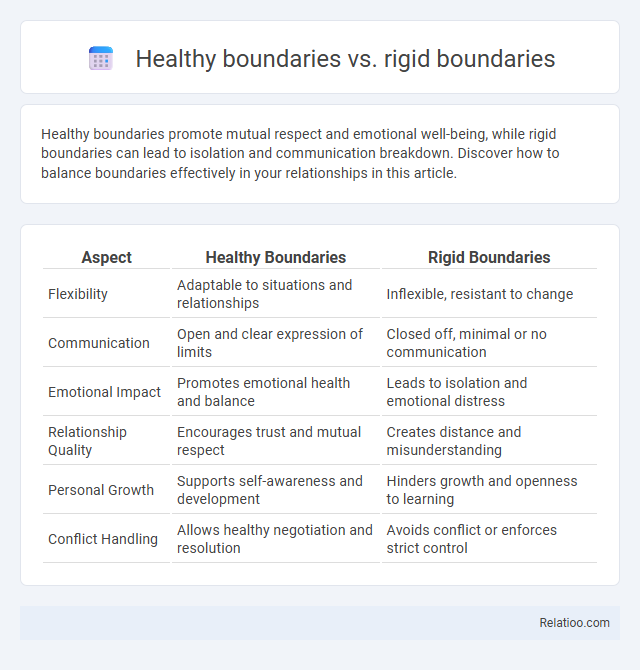Healthy boundaries promote mutual respect and emotional well-being, while rigid boundaries can lead to isolation and communication breakdown. Discover how to balance boundaries effectively in your relationships in this article.
Table of Comparison
| Aspect | Healthy Boundaries | Rigid Boundaries |
|---|---|---|
| Flexibility | Adaptable to situations and relationships | Inflexible, resistant to change |
| Communication | Open and clear expression of limits | Closed off, minimal or no communication |
| Emotional Impact | Promotes emotional health and balance | Leads to isolation and emotional distress |
| Relationship Quality | Encourages trust and mutual respect | Creates distance and misunderstanding |
| Personal Growth | Supports self-awareness and development | Hinders growth and openness to learning |
| Conflict Handling | Allows healthy negotiation and resolution | Avoids conflict or enforces strict control |
Understanding Boundaries: A Key to Healthy Relationships
Healthy boundaries enable individuals to communicate needs and limits clearly while maintaining respect and flexibility in relationships. Rigid boundaries, characterized by inflexibility and emotional distancing, often hinder intimacy and mutual understanding. Protecting personal well-being involves setting appropriate boundaries that balance self-care with openness, fostering trust and emotional safety.
What Are Healthy Boundaries?
Healthy boundaries are flexible limits that allow individuals to maintain personal integrity while fostering respectful and trusting relationships. They protect emotional well-being by clearly defining acceptable behavior without causing unnecessary restriction or isolation. Unlike rigid boundaries that often create distance, healthy boundaries balance protection with openness, promoting both self-respect and meaningful connection.
Signs and Benefits of Healthy Boundaries
Healthy boundaries are characterized by clear communication, mutual respect, and flexibility that allows for personal growth, while rigid boundaries often lead to isolation and hinder relationship development. Signs of healthy boundaries include feeling safe to express your needs, maintaining your values without fear, and experiencing balanced relationships where give-and-take is evident. Establishing healthy boundaries benefits your mental well-being by reducing stress, promoting self-respect, and fostering trust in both personal and professional connections.
Defining Rigid Boundaries: When Limits Become Barriers
Rigid boundaries occur when personal limits become inflexible barriers that prevent healthy communication and connection, often resulting in isolation and misunderstanding. Unlike healthy boundaries that balance self-respect with openness, rigid boundaries block vulnerability and emotional exchange, creating distance in relationships. Establishing protection involves setting firm yet adaptable limits that safeguard well-being without shutting out support or growth opportunities.
Recognizing Signs of Rigid Boundaries
Rigid boundaries often manifest through excessive withdrawal, inflexibility, and difficulty trusting others, which can hinder emotional intimacy and personal growth. You may notice signs such as unwillingness to compromise, persistent defensiveness, and isolation from social connections. Understanding these indicators helps differentiate healthy boundaries, which promote mutual respect and protection without causing disconnection.
Healthy vs Rigid Boundaries: Key Differences
Healthy boundaries promote balanced relationships by allowing flexibility and mutual respect, fostering open communication and emotional safety. Rigid boundaries create distance and disconnection, often leading to isolation or misunderstandings due to their inflexibility and resistance to compromise. Your ability to differentiate these boundaries improves emotional well-being and strengthens interpersonal connections.
Emotional Impact: Healthy Boundaries vs Rigid Boundaries
Healthy boundaries promote emotional well-being by allowing individuals to express needs and feelings openly while maintaining respect for others, fostering trust and meaningful connections. Rigid boundaries often lead to emotional isolation, as excessive defensiveness or detachment prevents vulnerability and hinders intimate relationships. Protection serves as the foundation for establishing boundaries that balance safety with emotional openness, ensuring psychological resilience without sacrificing interpersonal closeness.
Common Causes of Rigid Boundaries
Rigid boundaries often stem from past trauma, fear of vulnerability, or experiences of betrayal, leading individuals to excessively guard their personal space. These inflexible limits can hinder emotional connections and create barriers in relationships, contrasting with healthy boundaries that balance self-protection and openness. Your awareness of these common causes enables you to recognize when protection shifts into rigidity, promoting healthier interactions.
Strategies for Cultivating Healthy Boundaries
Cultivating healthy boundaries involves recognizing personal limits while maintaining flexibility to adapt to varying social contexts, unlike rigid boundaries which can lead to isolation or conflict. Effective strategies include clear communication of needs, consistent self-awareness practices, and assertiveness training to ensure respect without alienation. Balancing protection and openness supports emotional well-being and fosters genuine, resilient relationships.
Steps to Move from Rigid to Healthy Boundaries
Establishing healthy boundaries involves recognizing rigid boundaries as overly inflexible defenses that block meaningful connections and hinder personal growth. You can move from rigid to healthy boundaries by gradually practicing self-awareness, expressing your needs assertively, and allowing flexibility in interactions without compromising your values. This process protects your well-being while fostering balanced relationships built on respect and trust.

Infographic: Healthy boundaries vs rigid boundaries
 relatioo.com
relatioo.com